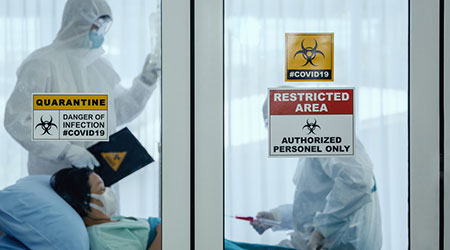Sometimes in our lifetimes we witness a rare convergence of market need and technology. The market need today is easily identified – the worldwide demand for new personal protection products and innovations that effectively lead to successful mitigation of airborne pathogens for personal safety at all levels of society.
The pandemic has shed new light on our society’s systemic weaknesses in our healthcare system, in our economy, and in social safety nets and has spurned the exploration of existing and new materials for protection. A new technology to meet this need can now be incorporated in a traditional LED panel fixture using nanometer materials for antiseptic and anti-virus air-cleaning. Materials with structures at the nanoscale often have unique properties.
Nanofiber materials achieve their differences from normal fiber production methods with "electrospinning" technology which utilizes electric force to draw charged threads of polymer solutions for mass production of nanofiber. Nanofiber generated from electrospinning entangles and bonds together and is then made into porous non-woven material without any additional weaving process or electrostatic charging.
Ultrafine nanofiber with pore size of 0.1㎛ (the diameter is only tens to hundreds of nanometers) and with approximately 640,000 strands per hair Its diameter is ultrafine and uniform and has a very high porosity owing to 3D pore size. Moisture generated by inhalation and exhalation can also be moved outwards quickly helping maintain comfortable at all time.
Applying nano technology in the manufacturing of filtering materials and incorporating them into an LED light panel system can now lend itself to new levels of safety heretofore not considered in pre-corona virus world. Imagine an LED panel with an internal air circulation system that cleans the air while reducing air particles that is antibiosis, antiviral, eliminating formaldehyde, benzene, toluene, xylene, ammonia and TVOC concentrations in a prescribed area with 24-hour operation if the light on or off.
Lumen output characteristic is 3,600 lumens with a CRI>80, providing just enough intensity to deliver the volumetric effect of light required for specific clinical or patient areas. The cover is made of high-quality ABS/plastic with frosted diffusion for optimum light distribution that minimizes contrast between the fixture and the work plane.
The air filtration system consists of a separable plastic lattice with an internal four-layer constitution for dust removal, antivirus, and decomposing organic gases. It consists of two outer layers (top and bottom) of a 30g/m² non-woven fabric for dust extraction, 180g/m² activated carbon layer for odor elimination, and a 300g/m² non-woven antimicrobial treated fabric made with nanometer material for decomposition of organic gases coated with silver ions which react with hydrogen sulfide ions in bacteria and inhibits their reproduction.
For these reasons, a paradigm shift towards nano material usage to combat the health crisis we all face is required for the many heroes on the front lines of the current pandemic. While many have the privilege to work from home, so many of the most vulnerable from our society do not have this luxury. Not only doctors and nurses, but essential workers - grocery clerks, amazon delivery drivers, transportation workers - all who are placed in harm’s way on a daily basis deserve nothing less than the maximum protection society can offer.
Howard Weinberg is the President of Emergence Technologies, LLC.

 Grounding Healthcare Spaces in Hospitality Principles
Grounding Healthcare Spaces in Hospitality Principles UC Davis Health Selects Rudolph and Sletten for Central Utility Plant Expansion
UC Davis Health Selects Rudolph and Sletten for Central Utility Plant Expansion Cape Cod Healthcare Opens Upper 2 Floors of Edwin Barbey Patient Care Pavilion
Cape Cod Healthcare Opens Upper 2 Floors of Edwin Barbey Patient Care Pavilion Building Sustainable Healthcare for an Aging Population
Building Sustainable Healthcare for an Aging Population Froedtert ThedaCare Announces Opening of ThedaCare Medical Center-Oshkosh
Froedtert ThedaCare Announces Opening of ThedaCare Medical Center-Oshkosh